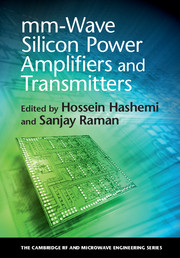Book contents
- Frontmatter
- Contents
- List of Contributors
- Preface
- 1 Introduction
- 2 Characteristics, performance, modeling, and reliability of SiGe HBT technologies for mm-wave power amplifiers
- 3 Characteristics, performance, modeling, and reliability of CMOS technologies for mm-wave power amplifiers
- 4 Linear-mode mm-wave silicon power amplifiers
- 5 Switch-mode mm-wave silicon power amplifiers
- 6 Stacked-transistor mm-wave power amplifiers
- 7 On-chip power-combining techniques for mm-wave silicon power amplifiers
- 8 Outphasing mm-wave silicon transmitters
- 9 Digital mm-wave silicon transmitters
- 10 System-on-a-chip mm-wave silicon transmitters
- 11 Self-healing for silicon-based mm-wave power amplifiers
- Index
- References
5 - Switch-mode mm-wave silicon power amplifiers
Published online by Cambridge University Press: 05 April 2016
- Frontmatter
- Contents
- List of Contributors
- Preface
- 1 Introduction
- 2 Characteristics, performance, modeling, and reliability of SiGe HBT technologies for mm-wave power amplifiers
- 3 Characteristics, performance, modeling, and reliability of CMOS technologies for mm-wave power amplifiers
- 4 Linear-mode mm-wave silicon power amplifiers
- 5 Switch-mode mm-wave silicon power amplifiers
- 6 Stacked-transistor mm-wave power amplifiers
- 7 On-chip power-combining techniques for mm-wave silicon power amplifiers
- 8 Outphasing mm-wave silicon transmitters
- 9 Digital mm-wave silicon transmitters
- 10 System-on-a-chip mm-wave silicon transmitters
- 11 Self-healing for silicon-based mm-wave power amplifiers
- Index
- References
Summary
Introduction to switching power amplifiers
Switch-mode power amplifiers (PAs) are motivated by the insight that power-amplifier efficiency is maximized by minimizing the amount of overlap between device current and device voltage. In other words, it is desirable to minimize the amount of time spent by the device supporting a non-zero current and non-zero voltage simultaneously. Switch-mode power amplifiers accomplish this by employing the active device as a switch that transitions between two states – an ON state, where the resistance of the device is ideally zero and in practice small compared with the other impedances in the circuit, and an OFF state, where the resistance of the device is ideally infinite and in practice high compared with the other circuit impedances. Consequently, the active device forces the current and voltage waveforms to be non-overlapping – during the ON state, the switch supports non-zero current but the voltage across it is close to zero, and during the OFF state, the switch supports non-zero voltage but the current through it is zero. Under idealized conditions, 100% efficiency can be achieved assuming switching losses are eliminated. This typically requires the voltage across the switch to be shaped to zero at the end of the OFF state as the switch is turning ON, so that the switch is not turned ON with non-zero charge stored on its output capacitance. Assuming such a “zero-voltage switching” (ZVS) condition is met, 100% efficiency can be achieved, unlike for current-source-based power amplifiers, where 100% efficiency can be achieved only in class-C operation as the output power approaches zero or by using class-F tuning, where 100% efficiency is achieved asymptotically with infinite harmonic tuning. In practice, however, the efficiency is limited by parasitic effects, such as conduction loss in the non-zero switch resistance and loss in the passive output matching network.
Switch-mode power amplifiers are distinct from their current-source counterparts (Fig. 5.1) in that they are (at least partially) voltage-forcing amplifiers. During the ON portion of the RF cycle, the device voltage is forced to ground through the switch, and during the OFF portion, the voltage is determined either by the load network or perhaps by the presence of a complementary switch (as is the case in inverter-like class-D power amplifiers).
- Type
- Chapter
- Information
- mm-Wave Silicon Power Amplifiers and Transmitters , pp. 180 - 206Publisher: Cambridge University PressPrint publication year: 2016



